This content is archived from the Feline Nutrition Foundation
Malaysian Kittens Meet Frankenprey!
- Updated: Saturday, June 01, 2019 05:21 PM
- Published: Saturday, September 23, 2017 03:46 PM
- Written by Ramesh Gopal
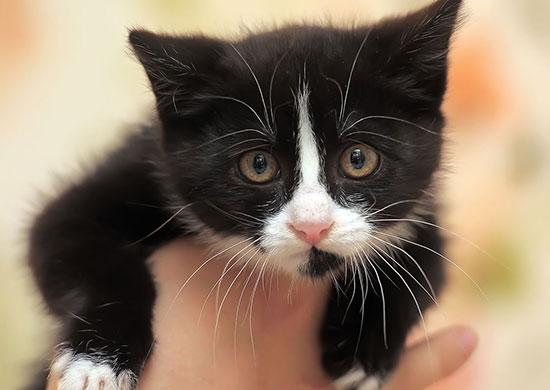 We recently rescued a trio of three-week-old feral kittens whose mother had died in our yard due to causes unknown. Fortunately, they were just at the point of being weaned. Thus began our journey into raw feeding. To put things in perspective, we had never been pet owners, nor rescuers. Other than feeding scraps to the occasional stray that wandered into our yard, we hadn't cared for pets during our adult lives. So, this was our first real rescue and fostering operation. This account takes place seven weeks after we began raw feeding these rescues.
We recently rescued a trio of three-week-old feral kittens whose mother had died in our yard due to causes unknown. Fortunately, they were just at the point of being weaned. Thus began our journey into raw feeding. To put things in perspective, we had never been pet owners, nor rescuers. Other than feeding scraps to the occasional stray that wandered into our yard, we hadn't cared for pets during our adult lives. So, this was our first real rescue and fostering operation. This account takes place seven weeks after we began raw feeding these rescues.
The internet is filled with information on raw feeding cats and dogs. For some, the problem might be that there's too much information. If you're just starting out, or thinking of raw feeding, it can be difficult to navigate the deluge of sometimes conflicting information online. So, as an aid to newcomers - and to add to the collection of war stories – here's our raw feeding experience, plus a simplified how-to guide. This is a tale told from the perspective of total newbies in both caring for cats and raw feeding.
Another important disclosure: we have learned and adapted and sometimes improvised as we went along. We didn't start off knowing and doing everything correctly from the start.
Deciding to Go Raw
For about a week or so, the kittens were fed milk from a saucer. And then one day, the runt of the litter decided he had had enough of milk, and started biting the rim of the saucer. That prompted us to think about feeding solids. But, what solids?
Our research into appropriate solids for cats led us to the Feline Nutrition website where we learned about raw feeding and its benefits. One touted benefit in particular caught our attention: low odour stools! You might laugh, but the main reason we've never cared for cats is because our yard had been frequently used by the neighbourhood cats as their toilet. And boy did their poop stink! So if raw feeding led to low-odour stools, then that would be a big win for us.
The other benefit we liked was plain economics. Where we live, kibble is relatively expensive. Even the low-grade stuff is expensive relative to its nutritional value. We had reckoned that the low-grade kibble was so bad for pets that it shouldn't be used for anything except maybe the mass feeding of strays. And we were not prepared to spend a fortune on high-end kibble, canned wet food or even human-grade canned tuna.
As semi-retired professionals, we wanted the biggest bang for our buck, while ensuring our fosters were eating an appropriate and balanced diet. That meant no carbohydrates, but with meat an expensive option, what was the best approach?
A key realization was that where we live, human-grade chicken and chicken parts are plentiful and cheap. And since chicken is the cheapest and the largest source of protein here, strict regulations and quality control also ensure that chicken sold here is very safe.
Our Approach
 Combining the advice on this site and others, plus the economics and other benefits, we decided to feed our kittens raw, home-made frankenprey chicken meals. For the uninitiated, frankenprey is a raw feeding technique that attempts to approximate the whole prey that cats would eat in the wild, usually birds, rodents, insects and small mammals. But instead of feeding a cat whole prey, the frankenprey approach tries to create a balanced meal out of parts obtained separately. These parts can either be served in chunks or ground up.
Combining the advice on this site and others, plus the economics and other benefits, we decided to feed our kittens raw, home-made frankenprey chicken meals. For the uninitiated, frankenprey is a raw feeding technique that attempts to approximate the whole prey that cats would eat in the wild, usually birds, rodents, insects and small mammals. But instead of feeding a cat whole prey, the frankenprey approach tries to create a balanced meal out of parts obtained separately. These parts can either be served in chunks or ground up.
Before we share more, there are a few important things to bear in mind. First, you're going to find a lot of confusing and conflicting information on the internet. It is important to keep key principles in mind while at the same time not falling into the trap of being dogmatic - i.e. there is only one way to achieve an outcome.
Many people are passionate about their pets and raw feeding, and they may come across online as overbearing. We would suggest that you learn as much as you can, and continue learning, while keeping an open mind. Come up with and adapt your own way of raw feeding your cat.
As long as you keep some guiding principles in mind - we'll talk about this later - feel free to improvise based on your common sense, as well as your available time, money, equipment and fresh food sources near where you live. You need not be cowed into blindly following what is said by zealots - usually passionate members of the raw feeding community - or professionals, usually vets.
Second, our story describes one of many ways to approach raw feeding. It is by no means the final word on raw feeding
Third, we're raw feeding our cats frankenprey chicken only, without supplements. They've taken to it without any issues. Your cats might have different preferences. Plus, our cats do not have any medical conditions which require dietary control and we have not had to transition them from other foods to raw. If your situation is different, then do spend some time online learning how others have tackled these issues.
Finally, you'll also find people recommending free-range, or antibiotic free meat. If you can source these fresh locally and if you can afford the asking price, go for it. But it's not a showstopper if you can't get it, or can't afford it.
Guiding Principles
So here are the "big" rules that guide us. These principles came out of synthesizing what we've learned from multiple sources and are built on everything the raw feeding community, vets and researchers have learned and shared over the last two decades.
- No carbohydrates. No kibble, certainly. We also don't add any plant matter to the food we feed our kittens.
- Balanced meals of meat, fat, bone and organs are important. We do not practice supplementation, although others might.
- Balance also means that proportions or ratios should be generally followed. We don't measure everything slavishly, but we do try to ensure that meals are approximately within the proportions recommended.
- Make sure there's lots of taurine in the food. Hardworking muscle meats, which is dark meat in poultry, offer this.
- Bone in some form is a must, both for its own nutritional value and to balance the phosphorus in meat. If you're interested, research the "calcium phosphorus balance." You could add calcium if you're supplementing, but raw bone is best as it has other minerals, too.
- Besides bone, the meat we feed our cats also contains skin, sinew and fat. Fat is especially important, but we try not to overdo it.
- We feed liver in tiny portions, and other organs as they're available.
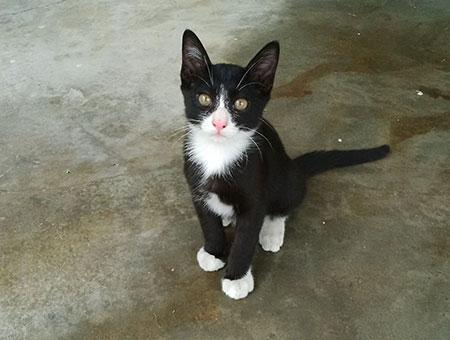 Every cat has their own idiosyncrasies regarding what they would like to eat, how large a chunk they can handle, how fast they eat and even how much they want to eat in one sitting. Since we do not free-feed our cats, this must be taken into account when planning raw frankenprey meals.
Every cat has their own idiosyncrasies regarding what they would like to eat, how large a chunk they can handle, how fast they eat and even how much they want to eat in one sitting. Since we do not free-feed our cats, this must be taken into account when planning raw frankenprey meals.
There's an observation we've made about fat. We have noticed that when we've fed the kittens meat with little or no fat, they seemed to want to eat more. But when they get an appropriate portion of fat, it seems to satiate them sooner. While we wouldn't advise overdoing it, this is something to keep in mind.
A Tentative Start
Without sufficient knowledge or a raw feeding plan, we initially fed the kittens raw scraps from chicken mostly and other meats, after the meats were trimmed. This lasted a few days as we experimented with different raw scraps, until we outlined a more structured way of raw feeding. We also made some initial mistakes, such as feeding too much liver, insufficient bone, and perhaps not enough dark meat. Thankfully, these mistakes were corrected as soon as we learnt of the possible negative effects. You don't have to do what we did, and you can certainly jump straight in to a more structured approach!
Equipment
There's no denying that raw feeding requires prep time and calls for the use of equipment around the house. Here then are the essentials we find indispensable.
- Freezer space. The more you have, the larger the batches you can prepare ahead of time. This is a must, unless you live next door to a 24-hour fresh food source.
- A pair of poultry shears. This helps make quick work of the chicken parts we process. We prefer the shears with detachable blades, which makes cleaning easy and thorough.
- A decent kitchen scale would be nice to have, some would say essential, but since we buy stuff which already has the weight on the label, it is easy to perform some arithmetic and then chunk and portion things appropriately. We are not slaves to exact numbers, so as long as the proportions are generally respected. We also find eyeballing it a lot less stressful and makes for quicker work. If you're unsure, though, you should weigh stuff so you know how much you're feeding your cats.
Our Recipe
Raw feeding guides suggest 2-4% of ideal body weight as the daily amount to feed a cat, but that's typically for older cats and is what's considered "maintenance mode." Our kittens are still growing and are ridiculously active outdoor cats so they typically consume anywhere from 6-10% of body weight per day!
Typical raw feeding guides call for about 80% meat (including muscle, sinew and fat), about 10% meaty bones, about 5% liver, and about 5% other organs. We typically feed our cats about 85% meat, slightly over 10% meaty bones, and about 5% liver. We adjust accordingly when we're able to find other non-liver organs - not so easy!
Our core recipe is basically made up of the following chicken parts:
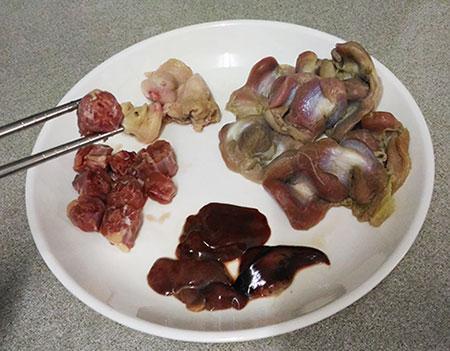
- Chicken gizzards. This is the largest component of what we feed our cats. Roughly 70-80% of the meat we feed them is from gizzards. We buy these in packs containing whole gizzards which have been sliced open and cleaned. Editor's note: We would recommend that this portion be comprised of muscle meat, including hearts, rather than be entirely gizzards.
- Chicken necks. We buy these in packs containing skinless necks with about 6-8 vertebrae on each neck. The necks also contain a little meat, which provides a good workout for the cats' jaws and teeth in learning to strip meat off bone.
- The "Bishop's nose" a.k.a. the chicken's butt! This is an excellent part which contains a little meat, skin, quite a bit of fat and a little bit of bone. We are not sure if this is something commonly sold where you might live.
- Chicken livers. The livers we get also sometimes have the hearts attached, and also another secreting organ, we don't know which. Hearts count as muscle meat - a great source of taurine - and our cats get them when it is available.
Besides the core recipe, the occasional raw trimmings we get from preparing other meats for cooking are also kept and fed to the cats. But we try not to overdo the fat. We have also fed our cats chicken wings, but these are very expensive here, so necks are a better deal overall. Shopping for the above is usually done a few times a week. We are fortunate to have a neighbourhood store which stocks all of the above, so we don't tend to keep more than a few days of the main meat component in the freezer.
Prep
Frankenprey requires a bit more work on the prep side as you'll need to observe how big a chunk your cat can handle. This varies from cat to cat, and depends on their jaw size, jaw strength and their own way of handling the chunks.
For our cats, we started with very small chunks, which could be essentially swallowed, and then gradually worked our way up. The good news is that this process can happen quickly.
Today, our three-month-old cats eat the following chunk sizes:
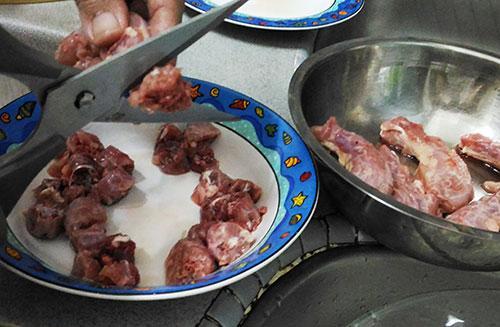
- Gizzards. When we started, gizzards were cut into quarters, and now they're onto halves. One kitten is even able to manage a whole gizzard, so long as it's not too large.
- Necks. Initially, the necks were cut into approximately two vertebrae sections and then a mallet or heavy stone was used to roughly crush the neck bones inside. Now, we cut the neck bones into single vertebra pieces, and we don't break the neck bone as their powerful little jaws are capable of crunching these single pieces. A little caveat is in order here. Cutting the neck vertebrae is hard work, and if you find the going tough, either get someone to assist, or use other bones which are easier to work with.
- The "Bishop's nose." These are fed whole to the kittens. Initially, they would strip off the meat and leave the tiny bone inside. Now, they have no problem tackling the whole thing, bone and all.
- Livers. After removing the hearts and secreting organ, if present, the livers are cut up into tiny pieces. You can and should use a weighing scale if you're unsure of how big a piece of liver should be. Handling, storing and thawing small pieces of liver can be cumbersome, so here's a tip: Place the cut pieces of liver on a flat tray or cookie sheet as you would cookies on a baking tray. Place the sheets into the freezer. When the pieces are frozen, remove them quickly and put into a jar or some other container. Return the livers into the freezer. You now have liver chips which can be individually taken out of the freezer, thawed and served!
As you might have guessed, everything that is cut up and portioned is frozen as quickly as possible. We prefer to store the different chunks separately, approximately for a day's needs. So gizzards would be stored in a bag or container for a day's needs. And besides the gizzards, very little cleaning is done on the various parts. The gizzards themselves are usually clean but, we do try to remove the tiny stones and some grit that may escape the initial processing.
Pre-feeding Prep
We usually take stuff we intend to feed the next day out of the freezer the night before and put it into the refrigerator. This helps the thawing process along. To assemble what's needed for feeding, we further thaw the chunks either under tap water, or if in a hurry, in the microwave. Raw feeding purists will likely cringe at the latter method, especially since many believe the "do not microwave" mantra with a religious fervour. We prefer a more middle-ground approach. The one thing we found was that our cats do not like their food cold. At the same time, too much heating would also cause nutrient loss and bones to become brittle.
So what we do instead is use the defrost or thaw function on our microwave, and serve the food either at or just slightly above room temperature. The optimal setting and time takes some figuring out, so if you don't have such a function on your microwave, or if you can't figure it out, then just use tap water, or warm water.
It's Feeding Time!
Our kittens are usually fed three times a day, four if there's the luxury of time. In addition, we do not free-feed, and the cats don't get anything to eat for about 10-12 hours in the night. This ensures that come "breakfast" time, they are hungry and ready for the hard work of slicing their food and breaking bones with their jaws. In addition to the above, our rescues do not get treats or other snacks. Initially, meaty bones were usually served in the morning, as hunger made them willing to put in the hard work. Now that their jaws are stronger, they will usually eat meaty bones at any meal.
There are also several tips we have found useful when feeding chunks:
First, a wide flat bowl, or even just a clean flat surface, is usually best. Cats need to learn how to handle chunks, and you might initially see them struggling with a piece. Don't intervene, unless it is a piece of bone which they cannot break - in which case, you should remove it if possible. It is not uncommon to see a kitten attempt to swallow a large chunk, and then regurgitate it to further cut smaller chunks off it.
Next, at least one of us also personally supervises the feeding process. This means giving each kitten one chunk at a time, and letting them finish each chunk before getting the next. This also means spacing the kittens out so that they're not eating too close to each other.
There are several reasons why this is done:
- Because cats eat at different speeds, having all the chunks in a bowl, with each cat having their own bowl, may result in a cat which eats faster stealing food from a slower one. Fights may even break out. The worst we've observed were threatening growls. Or you might find the slower eater taking the chunk and moving away from the feeding area and hiding to get some peace.
- We get to observe exactly how fast each cat eats, the chunk sizes he can handle, and how much he eats. This helps when chunking the parts during the prep process, and also ensures we know exactly how much each one is eating. This also helps with the shopping prep and saves money by avoiding wastage.
- Any uneaten chunks go back into the fridge for the day. Sometimes a cat may choose to stop eating. That's fine. What one cat doesn't eat can be either served back to it later, or served to another cat. So far, all uneaten portions have been consumed at a later meal the same day.
As each kitten is fed individual pieces, another useful tip is to use tongs or kitchen chopsticks to serve each piece. If you use your hands, an aggressive cat may inadvertently scratch you. We prefer stainless steel chopsticks which are easy to clean.
One other thing we do is we feed our cats any leftover juices from the process of thawing the raw chunks. Besides getting additional water, they also get the dissolved nutrients, so that's a win-win.
Differences from Conventional Wisdom and Practices
There is a body of conventional wisdom that has been built by the raw feeding community, a set of best-practices, if you will. Many practitioners believe the conventions to be cast in stone, so in the interest of full disclosure, you need to be aware of how our approach may differ from what is typically recommended, practiced, or both.
- We don't add supplements on top of what is fed. This is a choice best left to the judgement of the person preparing the food.
- We don't grind the food. Besides the additional work and the need for a decent grinder, we would prefer that our cats use their jaws and teeth the way nature intended them to. However, there is absolutely nothing wrong if you choose the raw ground approach.
- We don't serve a variety of meats. We had previously fed our rescues the rare fish, canned tuna, beef bits and lamb bits. But more recently, it has exclusively been chicken. Many purists recommend feeding a variety, but we don't for reasons of cost and availability.
- We use the microwave in the thawing process. If you know what you're doing and how to do it, and your microwave supports the function, then it is perfectly safe to use the microwave to do this job.
- We don't go looking for free-range, antibiotic-free meat. It's expensive. If you choose to do so, that's fine.
We don't sweat these differences, and you should feel free to adjust meals based on your circumstances, so long as the basic principles are adhered to.
Not All Roses
 It is also important to be realistic about raw feeding. It's not all roses. The prep work takes time. The feeding takes time, especially when thawing and serving. Supervising the feeding also takes time, if you choose to do this as we do. Storage in your freezer takes up space; you might need to spring for a second fridge or a chest freezer. The constant washing, cleaning and disinfecting, too, isn't something to get excited about. Some days you might feel like going back to kibble, which is effortless to feed by comparison.
It is also important to be realistic about raw feeding. It's not all roses. The prep work takes time. The feeding takes time, especially when thawing and serving. Supervising the feeding also takes time, if you choose to do this as we do. Storage in your freezer takes up space; you might need to spring for a second fridge or a chest freezer. The constant washing, cleaning and disinfecting, too, isn't something to get excited about. Some days you might feel like going back to kibble, which is effortless to feed by comparison.
We do look forward to the day when the rescues are older, and can eat larger chunks without the need for time-consuming preparation. But until then, the trade-offs seem worth it. Besides, most cats reach adulthood in a year, so unless you are a rescuer or serial kitten adopter, you will get a respite relatively quickly.
Concerns / Myths
There are some concerns and/or myths we and others have about a raw fed diet. Here are some of them:
- Raw food can be dangerous for cats. Not necessarily true. A cat's digestive system tolerates pathogens far better than a human's can. In fact, the biggest danger in raw feeding is contaminating the food you prepare for your family. As such, take sensible precautions and make sure to wash hands, surfaces, utensils and bowls thoroughly after preparation and feeding.
- Kittens need different food from adult cats. With the exception of feeding the kittens more frequent meals and maybe a tad bit more fat, this is the same diet we would happily feed an adult cat. In the wild, nature doesn't serve up kitten and adult fare, to be sure.
- Kittens can't handle bones. Again, not true. At almost three months, our kittens are crunching on chicken neck bones like champs. Cats also seem to be smart enough to know when to stop biting on a bone they can't handle.
- What if the cats were adopted and were not served a raw diet anymore? A valid concern, even one that we have. There are no easy answers, just the possibility of educating the adopters about the benefits of raw.
The Benefits
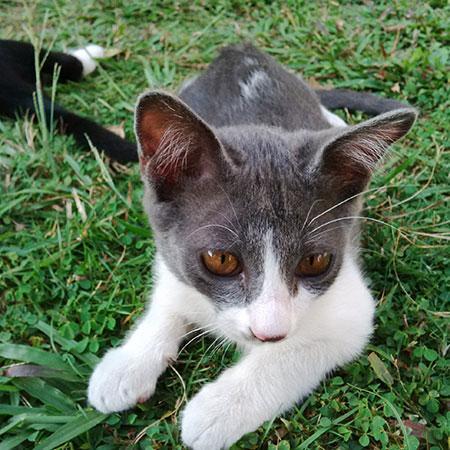 Thus far, the touted benefits have been realized, especially the poop part! Until you've experienced it for yourself, it is difficult to believe! The other things we've noticed is that the raw diet seems to give them boundless energy and soft, shiny coats. They play, fight, leap, knock over stuff, and otherwise seem happy kittens keen to explore their world. They also rarely, if ever, sip from their water bowl, but that's not surprising as they seem to be getting all the water they need from their food.
Thus far, the touted benefits have been realized, especially the poop part! Until you've experienced it for yourself, it is difficult to believe! The other things we've noticed is that the raw diet seems to give them boundless energy and soft, shiny coats. They play, fight, leap, knock over stuff, and otherwise seem happy kittens keen to explore their world. They also rarely, if ever, sip from their water bowl, but that's not surprising as they seem to be getting all the water they need from their food.
From the cost point of view, feeding raw may take more effort, and probably costs more upfront, but here are two things to consider: 1) Because a cat's digestive system extracts the most out of a raw food diet, there is very little that comes out the other end. With a kibble or canned diet, a lot of expensive product comes out the other end. Go watch "The Poop Question" on YouTube if you're not convinced! Ergo, raw food costs more upfront, but more nutrients are absorbed from raw foods than the equivalent amount of kibble or processed foods. 2) Another cost benefit is the likely reduction is vet visits for preventable ailments. The internet abounds with stories about raw diets preventing or even reversing cat diabetes, urinary tract blockages, and other common cat maladies which require expensive visits to the vet.
The Experience
We have been fortunate as our rescues went from zero to raw in no time at all. Except for once or twice when fish was tried and rejected, our kittens have eaten everything else without question. In addition, our kittens didn't want milk anymore after starting their raw diet, so they were essentially weaned before five weeks.
Additional Reading
Tales from the Trenches: Feeding Kittens a Raw Diet
Adoption: What Should We Feed Our New Kitten?
Based on our experience, we would strongly suggest that starting kittens on a raw diet early on in the weaning process would be the best approach for cats. Other than the additional effort of processing and handling the raw food, our rescues didn't face a difficult transition to raw, and they continue to eat what's served up with gusto. If nothing else, we hope we've given these three rescues a good start in life, and that they'll be strong and healthy enough to thrive in future.
Also, lots of credit to the Feline Nutrition site, and to the raw feeding community at large on the internet. We can truly say that we stood on shoulders of giants, and our three rescues benefitted immensely from the collective knowledge of the community.
Ramesh Gopal lives in Kuala Lumpur, Malaysia and when he isn't being a slave to three rescues, he works as a freelance consultant. Although he wrote this lengthy tale, all of the kitchen wisdom used in this raw feeding journey has come from his wife, who modestly wants to remain uncredited.




